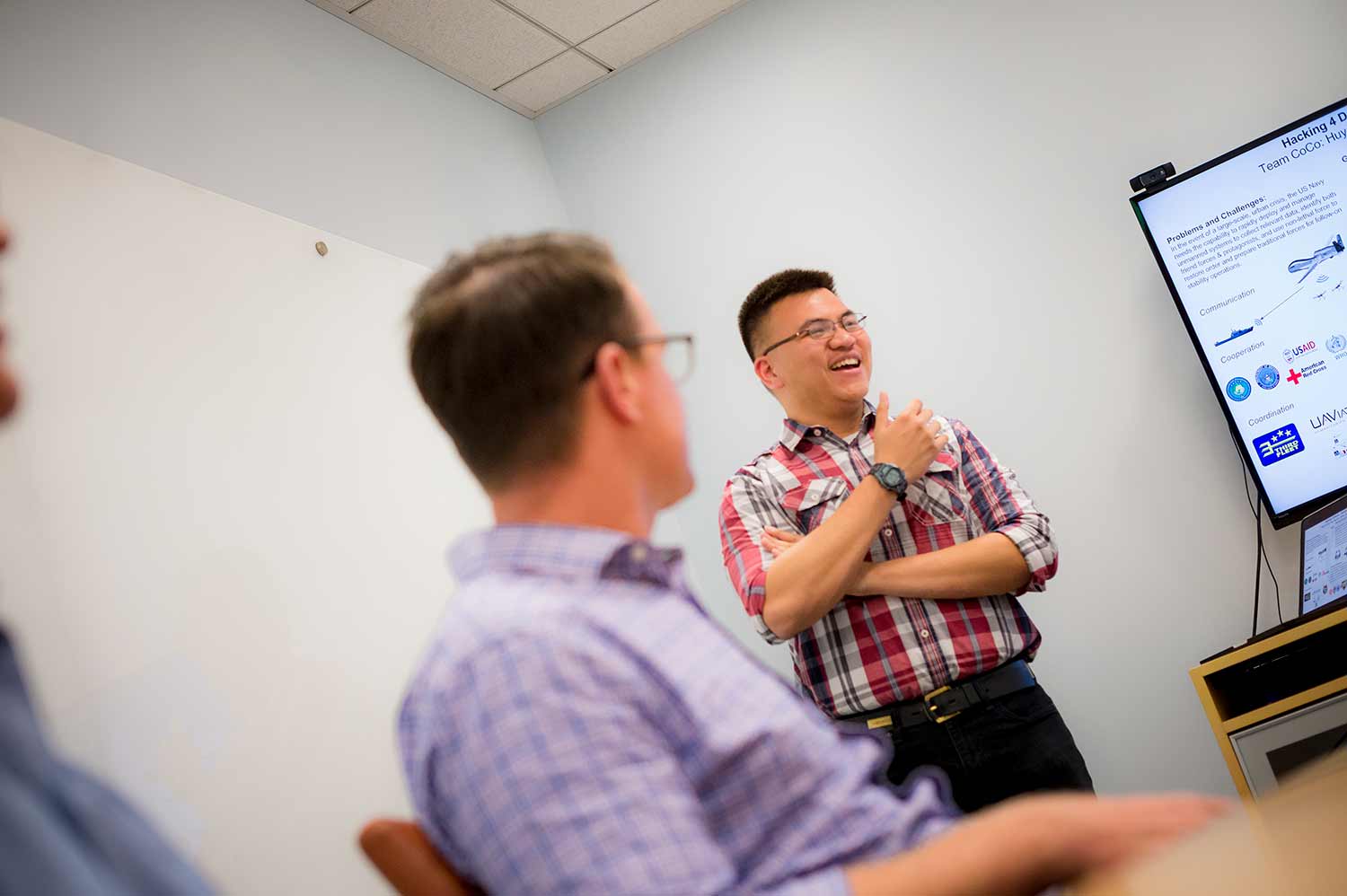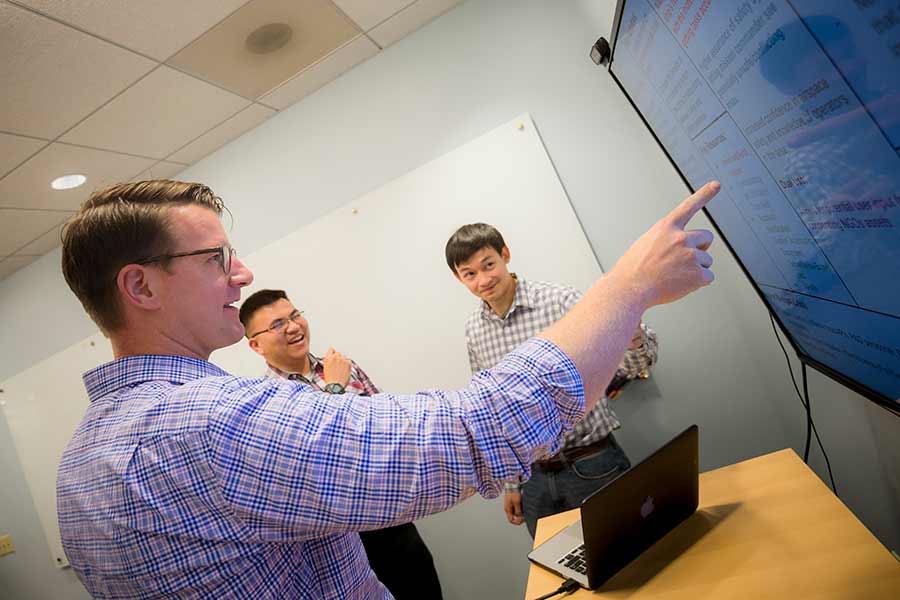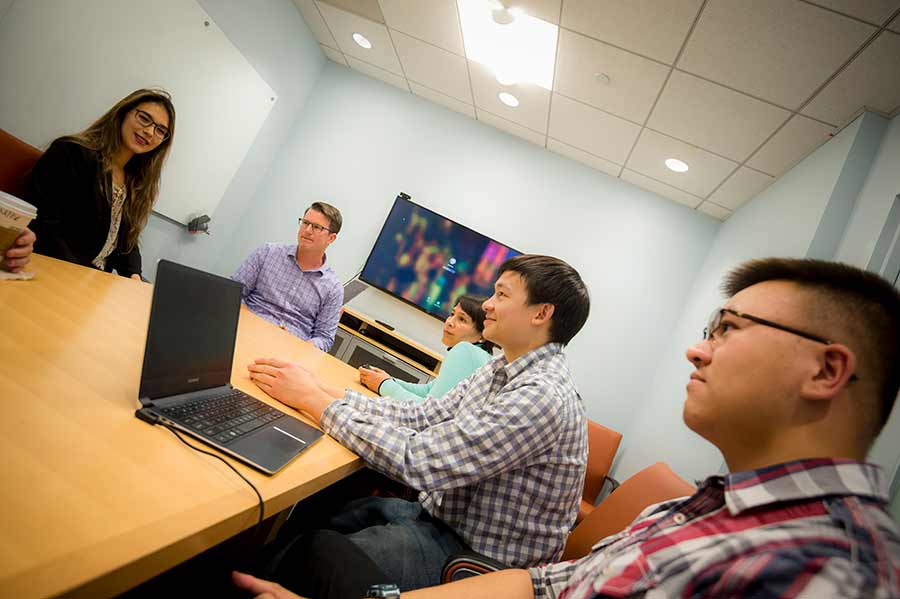
By:
- Deborah L. Jude
Published Date
By:
- Deborah L. Jude
Share This:

Student teams discuss their proposed solutions to military challenges with mentors and stakeholders during final presentations on Nov. 9, 2016. Photos by Erik Jepsen/UC San Diego Publications
Hacking for Defense: UC San Diego Students Tackle Military Challenges as Part of New Program
A new program at UC San Diego called Hacking for Defense gives students opportunities to leverage the culture of rapid innovation to address national security challenges.
UC San Diego students worked in teams on real-world problems identified by the U.S. Navy: humanitarian assistance involving robots and defense against underwater vehicle swarms.
Not only does the class provide military stakeholders with potential solutions to some of their most pressing challenges, it is also designed to get students excited about solving problems that are much bigger than themselves.
“We find that students that are exposed to this kind of learning become very enthusiastic because they realize their solutions may improve national security and save military lives,” said Ellen Chang, a former Navy captain and one of the instructors for the course at UC San Diego. “Rather than wait for a recruiter to come to campus, students can work with them on a real-world problem.”
In a pilot for the program that wrapped up this month, the humanitarian assistance team came up with a way to distinguish robots that are friends from those that are protagonists in crisis situations. They are already seeing ways their solution could be deployed.
“Recently, CalFire had to halt fire-fighting efforts during a fire because of unidentified drones in the area,” said third-year computer science major
Jason Park, who is part of the humanitarian assistance team. “The mission commander had to make the difficult decision to continue fighting the fire and save peoples’ homes or put his pilots at risk. The informational command and control interface that we are proposing could be able to assist with decisions like this by distinguishing assets from commercially available drones.”

Hacking for Defense mentor Justin Wells, second-year student at the Rady School of Management and former Navy helicopter pilot, helps the students refine their mission model canvas.
Hacking for Defense was originally launched at Stanford, and UC San Diego is the second institution to implement the program. The program is run by the Jacobs School of Engineering and is part of the UC San Diego Institute for the Global Entrepreneur, a joint collaboration between the Jacobs School and Rady School of Management.
The full, 10-week course will launch in Spring 2017. While the program is primarily for engineers, students from across campus are welcome to apply. All of the student projects are unclassified and open to UC San Diego students of all nationalities.
“Hacking for Defense is a great opportunity for our students to get hands-on experience working on real challenges facing our country,” said Albert P. Pisano, Dean of the Jacobs School of Engineering. “This is exactly the kind of experiential engineering education that we are focused on here at the Jacobs School.”
The course is taught using a variation on the Lean Launchpad Methodology developed by Steve Blank, an adjunct professor of Entrepreneurship and Innovation at Stanford, in which new businesses rapidly experiment and gather feedback from potential customers before executing any plans. (The approach is also used by the NSF Innovation-Corps program at UC San Diego.)
“The idea in Hacking for Defense is to rapidly iterate, pivot and build minimum viable products that can be developed further,” said Blank. “We replaced the business model canvas with a mission model canvas. The difference is that success is not measured by revenue, and the goal is to figure out how to deploy a solution, not demo it.”

Students engage with their mentors during the pilot of Hacking for Defense.
“This is not just a class, it’s the beginning of a way of thinking,” added Michael Krupp, Technology and Business Advisor at the UC San Diego Jacobs School of Engineering von Liebig Entrepreneurism Center.
Raina Borum, for example, is a fourth year NanoEngineering student on the underwater swarms team who plans to go to graduate school. She says the class highlighted how her interest in nanomedicine might overlap with the needs of the defense community.
Applications and solutions designed in Hacking for Defense classes could be viable in the private sector as well.
“One of the things we learned when coming up with the course is that 90% of the time, the military would love to buy their products commercially, off the shelf,” said Blank. “We encourage the students to think about dual-purpose solutions that could be funded by venture capital.”
When the class fully launches in April 2017, teams of UC San Diego students will work on eight problems sponsored by different branches of the military and the larger defense community. The student teams will get guidance from postdoctoral researchers or faculty members and at least one mentor from the military or defense community. The problems will range from preventing Department of Defense systems from cyber-attacks to biological warfare.
The two problems for the pilot course were proposed by the Office of the Undersecretary of the Navy for Unmanned Systems. Additional guidance and subject matter expertise support was provided by the Naval Postgraduate School.
At the end of the course, the organizations sponsoring the challenges have the opportunity to continue working with the students to develop their solution. Both teams from the pilot course will keep working with their sponsor to further their research and potentially productize their concepts.
Members of the military and defense communities who would like to get involved in Hacking for Defense at UC San Diego should contact Michael Krupp at mnkrupp@gmail.com.
Share This:
You May Also Like
Stay in the Know
Keep up with all the latest from UC San Diego. Subscribe to the newsletter today.


